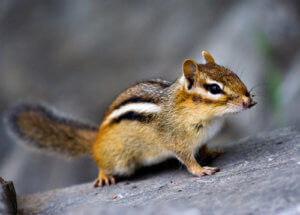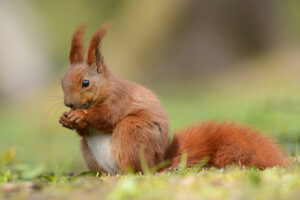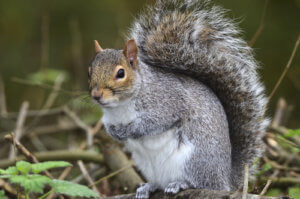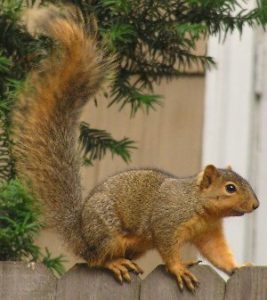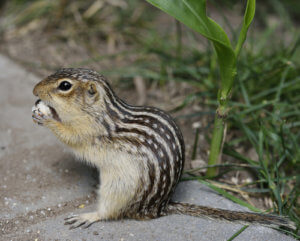Small but mighty, American red squirrels are a force to be reckoned with. Red squirrels differ from other tree squirrels by their deep reddish color, territorial behavior, and their smaller body size. Weighing in at roughly 7.1–8.8 oz, they are less than 30% the size of grey squirrels. Male and female American red squirrels are actually very similar in appearance.
Their fur color can vary greatly, depending on the season and where they live. Brownish or reddish are the natural colors of the upper parts. In summer, they have a black stripe along their sides; this separates the dark upper fur from the creamy or white underbelly fur. The squirrel’s tail is often edged with white and is not as thick as other North American tree squirrels. Distinctive white bands surround their large, black eyes. This squirrel’s compact body paired with strong claws and agile back legs allow them to excel at climbing and running through trees.
Habits and Diet
Red squirrels prefer staying up in the trees; because of this, they have a relatively long lifespan of 5 to 10 years. We rarely see a red squirrel down on the ground or at bird feeders, although they can occasionally be seen running along the tops of fences. They’re much faster than the larger tree squirrels, and their movements are quick and jerky. Their diet consists of seeds from coniferous trees such as pines, cedars, spruces, and firs, but they also do well with other high-energy food, such as peanuts. They store these food items in hollowed-out pine trees where they make their dens in rural environments. In more urban areas, these squirrels will chew their way into just about anything.
Communication
Their excellent senses of sight, smell, and hearing enable them to communicate with one another easily. They often make different sounds to call to each other, making distinctive noises as warning calls when they have to defend their territory. Body signals such as tail-jerking and foot stamping, chemical signals, and different sounds like a rattling buzz are the means to alert the other members of the tribe.
Problems Associated with American Red Squirrels
These squirrels can cause a slew of issues for Northern Michigan homes and businesses by nesting inside of structures. Once this happens, it turns into a generational situation in most cases, which will continue for years until something is done.
These squirrels are extremely talented climbers; they will use anything near the home to obtain access, such as wires and trees. They will even jump off of close access points if they are not directly touching. Red squirrels will chew into homes through the ridge vent, soffit, dormers, crawlspace vent, and any other pipe or accessible gap on a home. They are even known to chew into cedar shake and log homes to obtain direct access.
The same holds as they run along power lines, which can cause problems with transformers. American red squirrels can also carry a variety of diseases such as mange, cat scratch fever, typhus, and occasionally rabies; it is essential to avoid handling these animals.
These squirrels will need to be removed. Exclusion must be performed on their entry/exit points, as well as having trees trimmed back, fecal matter removed, and continued population control methods enforced so that if/when they do come back, they can be controlled before they do more damage to a structure. Red squirrels are incredibly aggressive and territorial, so once you have managed the population in your area, the problem will likely subside until the next reproduction cycle.
Red squirrels reproduce from May until June. Some females will have a second cycle around August, depending on their location. Eradication can be a time-consuming process, sometimes taking up to a month at certain times of the year. When temperatures drop in the winter months, they tend to move around significantly less, which can further draw out the removal process. We will do a thorough inspection of the structure to create the most effective plan possible for each specific situation.
